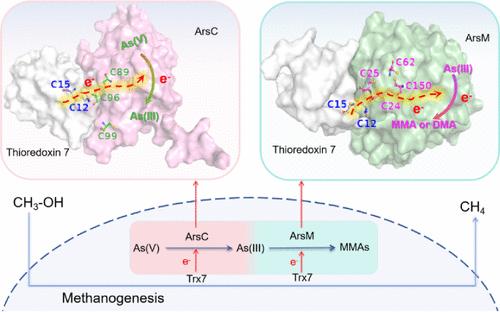当前位置:
X-MOL 学术
›
Environ. Sci. Technol.
›
论文详情
Our official English website, www.x-mol.net, welcomes your
feedback! (Note: you will need to create a separate account there.)
Molecular Basis of Thioredoxin-Dependent Arsenic Transformation in Methanogenic Archaea
Environmental Science & Technology ( IF 10.8 ) Pub Date : 2024-11-19 , DOI: 10.1021/acs.est.4c06611
Yanping Liang 1 , Yunfeng Yan 1 , Lulu Shi 2 , Mingyu Wang 2 , Xianzheng Yuan 1, 3 , Shuguang Wang 1, 3, 4 , Li Ye 5 , Zhen Yan 1
Environmental Science & Technology ( IF 10.8 ) Pub Date : 2024-11-19 , DOI: 10.1021/acs.est.4c06611
Yanping Liang 1 , Yunfeng Yan 1 , Lulu Shi 2 , Mingyu Wang 2 , Xianzheng Yuan 1, 3 , Shuguang Wang 1, 3, 4 , Li Ye 5 , Zhen Yan 1
Affiliation

|
Methanogenic archaea are known to play a crucial role in the biogeochemical cycling of arsenic (As); however, the molecular basis of As transformation mediated by methanogenic archaea remains poorly understood. Herein, the characterization of the redox transformation and methylation of As by Methanosarcina acetivorans, a model methanogenic archaeon, is reported. M. acetivorans was demonstrated to mediate As(V) reduction via a cytoplasmic As reductase (ArsC) in the exponential phase of methanogenic growth and to methylate As(III) via a cytoplasmic As(III) methyltransferase (ArsM) in the stationary phase. Characterization of the ArsC-catalyzed As(V) reduction and the ArsM-catalyzed As(III) methylation showed that a thioredoxin (Trx) encoded by MA4683 was preferentially utilized as a physiological electron donor for ArsC and ArsM, providing a redox link between methanogenesis and As transformation. The structures of ArsC and ArsM complexed with Trx were modeled using AlphaFold-Multimer. Site-directed mutagenesis of key cysteine residues at the interaction sites of the complexes indicated that the archaeal ArsC and ArsM employ evolutionarily distinct disulfide bonds for interacting with Trx compared to those used by bacterial ArsC or eukaryotic ArsM. The findings of this study present a major advance in our current understanding of the physiological roles and underlying mechanism of As transformation in methanogenic archaea.
中文翻译:

产甲烷古菌中硫氧还蛋白依赖性砷转化的分子基础
已知产甲烷古细菌在砷 (As) 的生物地球化学循环中起着至关重要的作用;然而,由产甲烷古细菌介导的 As 转化的分子基础仍然知之甚少。在此,报道了 Methanosarcina acetivorans(一种模型产甲烷古细菌)对 As 的氧化还原转化和甲基化的表征。M. acetivorans 被证明在产甲烷生长的指数期通过细胞质 As 还原酶 (ArsC) 介导 As(V) 还原,并在固定相通过细胞质 As(III) 甲基转移酶 (ArsM) 甲基化 As(III)。ArsC 催化的 As(V) 还原和 ArsM 催化的 As(III) 甲基化的表征表明,由 MA4683 编码的硫氧还蛋白 (Trx) 优先用作 ArsC 和 ArsM 的生理电子供体,在甲烷生成和 As 转化之间提供氧化还原连接。使用 AlphaFold-Multimer 对 ArsC 和 ArsM 与 Trx 复合的结构进行建模。复合物相互作用位点关键半胱氨酸残基的定点诱变表明,与细菌 ArsC 或真核生物 ArsM 使用的二硫键相比,古细菌 ArsC 和 ArsM 在进化上采用不同的二硫键与 Trx 相互作用。这项研究的结果为我们目前对产甲烷古细菌中 As 转化的生理作用和潜在机制的理解取得了重大进展。
更新日期:2024-11-19
中文翻译:

产甲烷古菌中硫氧还蛋白依赖性砷转化的分子基础
已知产甲烷古细菌在砷 (As) 的生物地球化学循环中起着至关重要的作用;然而,由产甲烷古细菌介导的 As 转化的分子基础仍然知之甚少。在此,报道了 Methanosarcina acetivorans(一种模型产甲烷古细菌)对 As 的氧化还原转化和甲基化的表征。M. acetivorans 被证明在产甲烷生长的指数期通过细胞质 As 还原酶 (ArsC) 介导 As(V) 还原,并在固定相通过细胞质 As(III) 甲基转移酶 (ArsM) 甲基化 As(III)。ArsC 催化的 As(V) 还原和 ArsM 催化的 As(III) 甲基化的表征表明,由 MA4683 编码的硫氧还蛋白 (Trx) 优先用作 ArsC 和 ArsM 的生理电子供体,在甲烷生成和 As 转化之间提供氧化还原连接。使用 AlphaFold-Multimer 对 ArsC 和 ArsM 与 Trx 复合的结构进行建模。复合物相互作用位点关键半胱氨酸残基的定点诱变表明,与细菌 ArsC 或真核生物 ArsM 使用的二硫键相比,古细菌 ArsC 和 ArsM 在进化上采用不同的二硫键与 Trx 相互作用。这项研究的结果为我们目前对产甲烷古细菌中 As 转化的生理作用和潜在机制的理解取得了重大进展。

































 京公网安备 11010802027423号
京公网安备 11010802027423号